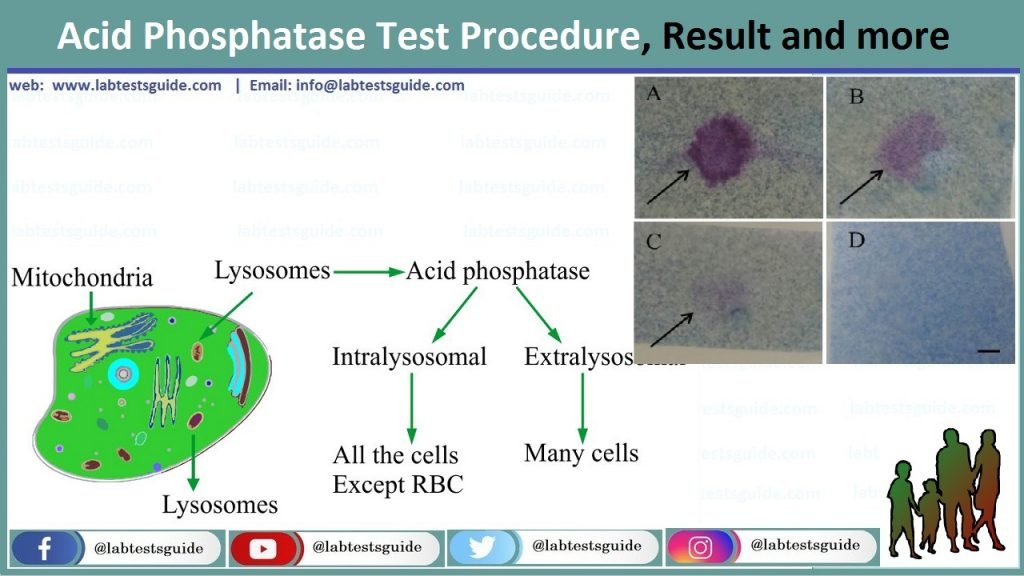Acid phosphatase: An enzyme that acts to release phosphate under acidic conditions and is produced in the liver, spleen, bone marrow, and prostate gland. Abnormally high serum levels of acid phosphatase may indicate infection, injury, or prostate cancer.
Known As:
Acid Phosphatase, Orthophosphoric-monoester phosphohydrolase (acid optimum), Acid Phosphatase [Chemical/Ingredient], acid phosphatase, Acid phosphatase, Acid phosphomonoesterase, ACP – Acid phosphatase, Acid phosphatase (substance)

Summary:
Acid Phosphatase (ACP) is an enzyme of the Hydrolase class of enzymes and acts in an acidic medium. It is widely distributed and found in high concentrations in the liver, RBC’s and the prostate. Increased levels of the prostatic fraction are associated with prostatic carcinomas. Increased levels of the non prostatic fraction are associated with liver diseases, hyperparathyroidism, and Paget’s disease.
Principle:
ACP at an acidic pH hydrolyses a Naphthylphosphate to form a Naphthol and Inorganic Phosphate. The a Naphthol formed is coupled with Fast Red TR salt to form a diazo dye complex. The rate of formation of this complex is measured as an increase in absorbance which is proportional to the ACP activity in the sample. Tartrate inhibits prostatic ACP and the testing in it’s presence is done to find the non prostatic ACP. The difference between the activities of the total and non prostatic ACP gives the activity of the prostatic ACP.

Sample:
- It is done on the serum of the patient and performs the test within one hour.
- How to get good serum: Take 3 to 5 ml of blood in the disposable syringe or in vacutainer. Keep the syringe for 15 to 30 minutes and then centrifuged for 2 to 4 minutes to get the clear serum.
- EDTA plasma is better because it stabilizes the acid phosphatase.
- A morning sample is preferred.
- Avoid hemolysis.
- The sample is stable for 24 hours at 2 to 8 °C.
- Try to do the test immediately.
- If serum is acidified below pH of 6.5 that will stabilize the enzyme.
Precaution
- It has poor stability in whole blood.
- ACP is unstable at room temperature >37 °C.
- ACP is unstable if the pH is >7.0.
- The serum is separated immediately and the test is performed within one hour.
- EDTA plasma is preferred that stabilizes the AP.
- Avoid prostatic massage in the last 48 hours.
- Hemolysis falsely raised the value.
- 50% of activity lost if kept at room temperature.
Normal Values:
- Total acid phosphatase
- 2.5 to 3.7 ng /mL or 2.5 to 3.7 µg/L.
- or less than 3.0 mg /L.
- Prostatic acid phosphatase = <2.5 ng/mL (0 to 0.6 U/L).
- Other reference
- Adult 0.13 to 0.63 units/L at 37 °C
- or 2.2 to 10.5 units/L (SI units).
- Child 8.6 to 12.0 units/mL at 30 °C.
- Newborn 10.4 to 16.4 units /mL at 30 °C.
Kit Content:
| Contents | 30×2 ml | 10 x 2 ml |
|---|---|---|
| L1 : Buffer Reagent | 25 ml | 75 ml |
| T1 : Substrate Tablets | 10 Nos. | 30 Nos. |
| L2 : Tartrate Reagent | 2 ml | 2 ml |
| L3 : Acetate Buffer | 2 ml | 2 ml |
Storage / stability:
Contents are stable at 2-8°C till the expiry mentioned on the labels.
Reagent Preparation:
- Reagents L2 and L3 are ready to use.
- The Buffer (L1) when retrieved from 2-8° C may appear turbid. However the turbidity clears up on attaining R.T. In case the turbidity persists a little warming of the Buffer to
- Working reagent: Dissolve 1 Substrate tablet (T1) in 2.2 ml of Buffer Reagent (L1). Allow the tablet to hydrate for around 5 min. and then shake to dissolve. This working reagent is stable for at least 3 days when stored at 2-8°C. The Working Reagent may be used for the Total ACP assay or the Non ProstaticACP assay as required.
System Parameters:
| Reaction | Kinetic |
| Wavelength | 405 nm |
| Light path | 1 cm |
| Zero Setting | Distilled water |
| lncub. Temp. | 30°C / 37°C |
| lncub. Time | |
| Delay Time | 300 sec. |
| Read Time | 180 sec. |
| No. of read. | 4 |
| Interval | 60 sec. |
| Sample Vol. | 0.10 ml |
| Reagent Vol. | 1.00 ml |
| Standard | 750.0 |
| Factor | |
| React. Slope | Increasing |
| Linearity | 75 U/L |
| Units | U/L |
Total ACP Assay:
Pipette into a clean dry test tube labelled as Test ( T) :
| Addition Sequence | (T) |
|---|---|
| Working Reagent | 1.0 ml |
| Sample | 0.1 ml |
Mix well and read the initial absorbance A,,after 5 minutes & repeatthe absorbance reading after every 1, 2, & 3 minutes. Calculate the mean absorbance change per minute (M/min.)
Non Prostatic ACP Assay: ( Tartrate Inhibited):
Pipette into a clean dry test tube labelled as Test ( T) :
| Addition Sequence | (T) |
|---|---|
| Working Reagent | 1.0 ml |
| Tartrate Reagen | 0.02 ml |
| Incubate at the assaytemperaturefor 1 minute and add | |
| Sample | 0.1 ml |
Mix well and read the initial absorbance A,,after 5 minutes & repeatthe absorbance reading after every 1, 2, & 3 minutes. Calculate the mean absorbance change per minute (M/min.)
Calculation:
ACP Activity in U/L = M / min x 750
Prostatic ACP Activity in U/L= TotalACP – Non ProstaticACP
Related Articles:
Possible References Used





